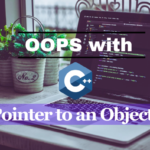Index
Let’s explore the concept of a pointer to an object in a heap by using an interesting example of a Book class. We will create an object dynamically (in the heap) and access it through a pointer.
Example: Book Class
We’ll create a Book class that has attributes like title, author, and pages. We’ll dynamically allocate memory for a Book object on the heap using a pointer, set its attributes, and display its details.
Code
#include <iostream>
#include <string>
using namespace std;
class Book {
public:
string title;
string author;
int pages;
// Method to display book details
void displayDetails() {
cout << "Title: " << title << endl;
cout << "Author: " << author << endl;
cout << "Pages: " << pages << endl;
}
};
int main() {
// Dynamically allocate memory for a Book object on the heap
Book* bookPtr = new Book();
// Set the attributes of the Book object
bookPtr->title = "1984";
bookPtr->author = "George Orwell";
bookPtr->pages = 328;
// Display the details of the book using the pointer
cout << "Book Details:" << endl;
bookPtr->displayDetails();
// Deallocate the memory (freeing the heap memory)
delete bookPtr;
return 0;
}
Output:
Book Details:
Title: 1984
Author: George Orwell
Pages: 328
Explanation:
Step 1: Create a Book Class:
- The
Bookclass has three public attributes:title,author, andpages. - It also has a method
displayDetails()that prints out the details of the book.
class Book {
public:
string title;
string author;
int pages;
void displayDetails() {
cout << "Title: " << title << endl;
cout << "Author: " << author << endl;
cout << "Pages: " << pages << endl;
}
};
Step 2: Heap Allocation:
- In the
main()function, we dynamically allocate memory for aBookobject using thenewkeyword. This creates the object on the heap and returns a pointer to it.
Book* bookPtr = new Book();
Step 3: Setting Attributes:
- Using the pointer
bookPtr, we set thetitle,author, andpagesattributes of theBookobject.
bookPtr->title = "1984";
bookPtr->author = "George Orwell";
bookPtr->pages = 328;
Step 4: Accessing Members Using Pointer:
- We call the
displayDetails()method using the pointer to display the book’s details.
bookPtr->displayDetails();
Step 5: Memory Deallocation:
- After we are done with the object, we free the allocated memory using the
deletekeyword to avoid memory leaks.
delete bookPtr;
Summary:
- Heap Allocation: The object is created on the heap, meaning its memory needs to be managed manually (using
newanddelete). - Pointer to Object: A pointer is used to access and manipulate the object in the heap.
- Memory Management: It’s important to release the memory when done using the
deletekeyword to avoid memory leaks.


